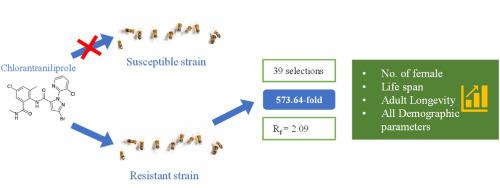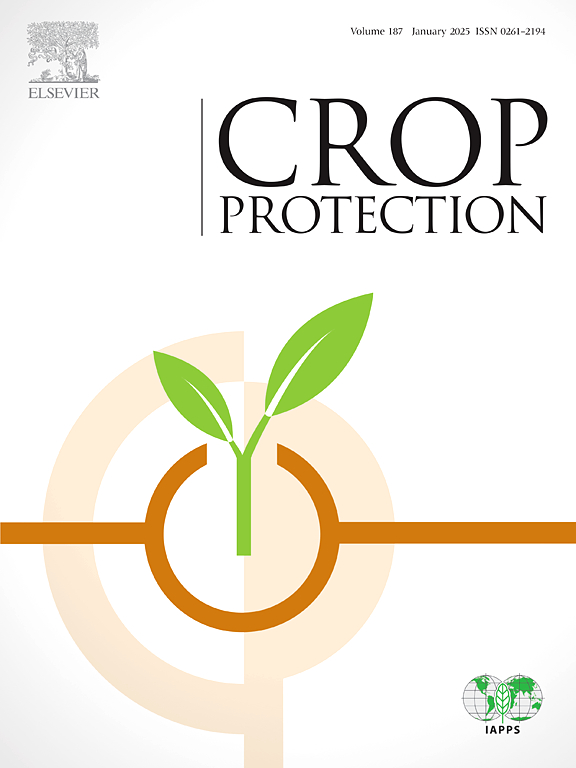Anthranilic diamide compatibility with the parasitoid Trichogramma chilonis Ishii (Hymenoptera: Trichogrammatidae): Based on Toxicity, Two-sex life table and ecological parameters
IF 2.5
2区 农林科学
Q1 AGRONOMY
引用次数: 0
Abstract
Egg parasitoid wasps of genus Trichogramma Westwood are effective natural enemies of lepidopteran pests in various crops. However, the efficacy of Trichogramma parasitoids is adversely affected by insecticides applied in the field to manage these lepidopteran pests. To overcome this problem efficiently, there is an urgent need to incorporate insecticide-resistant Trichogramma strains into integrated pest management (IPM) programs. This study assessed the potential of Trichogramma chilonis Ishii to develop chlorantraniliprole resistance and characterized resistance associated fitness costs and stability. Toxicity bioassays were performed on T. chilonis using a dry film residue method. After 39 selections, a 573.64-fold level of resistance to chlorantraniliprole was developed in the resistant strain of T. chilonis (Chlr-R) when compared with a chlorantraniliprole susceptible strain (Chlr-S). Chlorantraniliprole resistance in Chlr-R resulted in a female biased sex-ratio and significantly increased the total life span and longevity of the adult female when compared to the Chlr-S strain. Based on age-stage, two-sex life table all the demographic parameters of Chlr-R increased significantly. These results indicate that T. chilonis can be mass reared and selected for chlorantraniliprole resistance under laboratory conditions, is an important step to improve the in field-based effectiveness and integration of these wasps with chemical control.

蒽酰二胺与寄生虫 Trichogramma chilonis Ishii(膜翅目:Trichogrammatidae)的兼容性:基于毒性、双性生命表和生态参数
Trichogramma Westwood 属卵寄生蜂是各种作物中鳞翅目害虫的有效天敌。然而,田间使用杀虫剂来防治这些鳞翅目害虫时,会对 Trichogramma 寄生蜂的功效产生不利影响。为有效解决这一问题,迫切需要将抗杀虫剂的 Trichogramma 菌株纳入害虫综合治理(IPM)计划。本研究评估了 Trichogramma chilonis Ishii 产生氯虫苯甲酰胺抗性的潜力,并描述了与抗性相关的适应成本和稳定性。采用干膜残留法对 Chilonis 进行了毒性生物测定。经过 39 次筛选,T. chilonis 的抗性菌株(Chlr-R)与氯虫苯甲酰胺易感菌株(Chlr-S)相比,对氯虫苯甲酰胺产生了 573.64 倍的抗性。与 Chlr-S 株系相比,Chlr-R 的抗性导致性别比例偏向雌性,并显著延长了成年雌虫的总寿命和寿命。基于年龄阶段的双性生命表,Chlr-R 的所有人口统计学参数都显著增加。这些结果表明,T. chilonis 可以在实验室条件下进行大规模饲养并筛选出抗氯氰菊酯的品系,这对于提高这些蜂的田间防治效果以及将其与化学防治相结合是非常重要的一步。
本文章由计算机程序翻译,如有差异,请以英文原文为准。
求助全文
约1分钟内获得全文
求助全文
来源期刊

Crop Protection
农林科学-农艺学
CiteScore
6.10
自引率
3.60%
发文量
200
审稿时长
29 days
期刊介绍:
The Editors of Crop Protection especially welcome papers describing an interdisciplinary approach showing how different control strategies can be integrated into practical pest management programs, covering high and low input agricultural systems worldwide. Crop Protection particularly emphasizes the practical aspects of control in the field and for protected crops, and includes work which may lead in the near future to more effective control. The journal does not duplicate the many existing excellent biological science journals, which deal mainly with the more fundamental aspects of plant pathology, applied zoology and weed science. Crop Protection covers all practical aspects of pest, disease and weed control, including the following topics:
-Abiotic damage-
Agronomic control methods-
Assessment of pest and disease damage-
Molecular methods for the detection and assessment of pests and diseases-
Biological control-
Biorational pesticides-
Control of animal pests of world crops-
Control of diseases of crop plants caused by microorganisms-
Control of weeds and integrated management-
Economic considerations-
Effects of plant growth regulators-
Environmental benefits of reduced pesticide use-
Environmental effects of pesticides-
Epidemiology of pests and diseases in relation to control-
GM Crops, and genetic engineering applications-
Importance and control of postharvest crop losses-
Integrated control-
Interrelationships and compatibility among different control strategies-
Invasive species as they relate to implications for crop protection-
Pesticide application methods-
Pest management-
Phytobiomes for pest and disease control-
Resistance management-
Sampling and monitoring schemes for diseases, nematodes, pests and weeds.
 求助内容:
求助内容: 应助结果提醒方式:
应助结果提醒方式:


